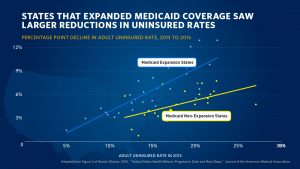
“Take Governor John Kasich’s explanation for expanding Medicaid: ‘For those that live in the shadows of life, those who are the least among us, I will not accept the fact that the most vulnerable in our state should be ignored. We can help them.’”
So quotes President Barack Obama in the Journal of the American Medical Association, JAMA, in today’s online issue. #POTUS penned, United States Health Care Reform: Progress to Date and Next Steps. The author is named as “Barack Obama, JD,” a nod to the President’s legal credentials.
Governor Kasich, a Republican, was one of 31 Governors who chose to expand Medicaid to cover health insurance for their states’ health citizens. 19 other Governors chose not to do so, and in their states, the health and health-economic impacts were negative. The first chart captures data on how the states expanding Medicaid have experienced larger reductions in the rate of uninsured in their states. Note the blue line and green line: the blue line represents Medicaid Expansion States, and the green, those states not expanding Medicaid. The rate of uninsured overall fell from 16.0% in 2015 to 8.1% in 2015, a decline of 43% nationally.
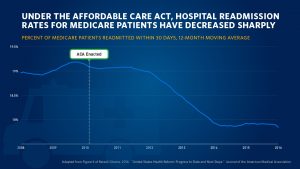
A second positive impact of the Affordable Care Act was the reduction of hospital readmission rates for Medicare patients. The second chart illustrates the dramatic decline in readmissions. This resulted from incentives (more accurately, dis-incentives) for hospitals to prevent older Americans from being readmitted into hospital inpatient beds within 30 days of being discharged for acute myocardial infarction (heart attack), chronic heart failure, and pneumonia.
The President also notes that there’s been an improvement in quality of care based on several measures: for example, the rate of hospital acquired conditions like adverse drug events and infections fell by 17%, from 145 per 1000 discharges in 2010 to 121 per 1000 discharges in 2014.
In his JAMA article, President Obama notes that the ACA has also begun to change how health care providers are paid, with about 30% of Medicare payments now reimbursed through value-based payment systems such as bundled payment and accountable care organizations. In 2018, Medicare seeks to make 50% of payments through value-based models.
There is still more work to do, the President writes, to improve the U.S. health care system. Insurance markets aren’t working as effectively or efficiently as the ACA envisioned, as some dramatically increasing premium rates will confront many health insurance consumers in 2017. Some local and state markets lack competition with only one or two health plans serving these areas. That is a risk for higher premium prices. The President argues for Congress to revisit a public plan to compete with the private insurers to promote competition (and lower prices).
Furthermore, some uninsured consumers cannot afford or will not pay for premiums, driving the need for more education about premium assistance and additional increases for financial assistance to ensure true “affordability” as promised in the law’s name.
Finally, prescription drug costs continue to challenge many consumers’ family budgets. Specifically, the President argues for giving the Federal government the authority to negotiate prices for “certain high-priced drugs,” he writes.
In conclusion, President Obama talks about lessons for future policy makers. Among them, he calls out,
- “Hyperpartisanship,” with some politicians reversing course and rejecting their own ideas when the President supported them, thus foiling progress for certain aspects of health care reform
- The challenge of special interests as obstacles to change, especially the pharmaceutical industry which has been resistant to changes in drug pricing
- The importance of pragmatism, with simpler approaches to addressing health care challenges being better than complex solutions.
You can read the President’s White House blog post here where he discusses this JAMA article.
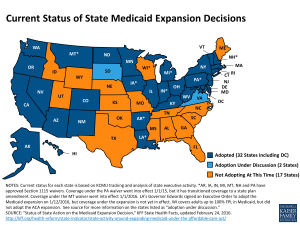 Health Populi’s Hot Points: A lot of us are visual learners, and maps can help us connect the dots that raw data sometimes can’t. Here, I posted the first map from the Kaiser Family Foundation which indicates the states that have expanded Medicaid (31 plus DC) and those that have not. Note the prevalence of orange throughout the southern states; these are the non-expansion states.
Health Populi’s Hot Points: A lot of us are visual learners, and maps can help us connect the dots that raw data sometimes can’t. Here, I posted the first map from the Kaiser Family Foundation which indicates the states that have expanded Medicaid (31 plus DC) and those that have not. Note the prevalence of orange throughout the southern states; these are the non-expansion states.
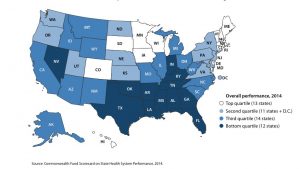 Now check out map #2, created by The Commonwealth Fund in their research into U.S. state’s health system performance. Note the predominant dark blue that is a remarkably similar footprint to the Medicaid non-expansion states.
Now check out map #2, created by The Commonwealth Fund in their research into U.S. state’s health system performance. Note the predominant dark blue that is a remarkably similar footprint to the Medicaid non-expansion states.
The Fund develops state-level scorecards for “health system performance” looking at state residents’ ability to:
- Access and afford health care
- Access prevention and treatment
- Avoid unnecessary hospital use and cost
- Live long and healthy lives
- Experience health equity.
Those dark-blue states have lower “grades” than other states. There is up to an 8-fold difference between the highest-performing states and the lowest-performing ones, the Fund calculated.
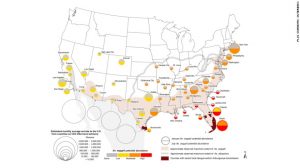 In 2014, Bill Moyers pointed out the growing gap between so-called red versus blue states. Political decisions have public health consequences, which are illustrated here with a proxy metric: that is, the CDC’s and NASA’s projections for the spread of the Zika virus. This, too, has a footprint akin to the maps illustrating Medicaid non-expansion and poor health system and state citizens’ health outcomes.
In 2014, Bill Moyers pointed out the growing gap between so-called red versus blue states. Political decisions have public health consequences, which are illustrated here with a proxy metric: that is, the CDC’s and NASA’s projections for the spread of the Zika virus. This, too, has a footprint akin to the maps illustrating Medicaid non-expansion and poor health system and state citizens’ health outcomes.


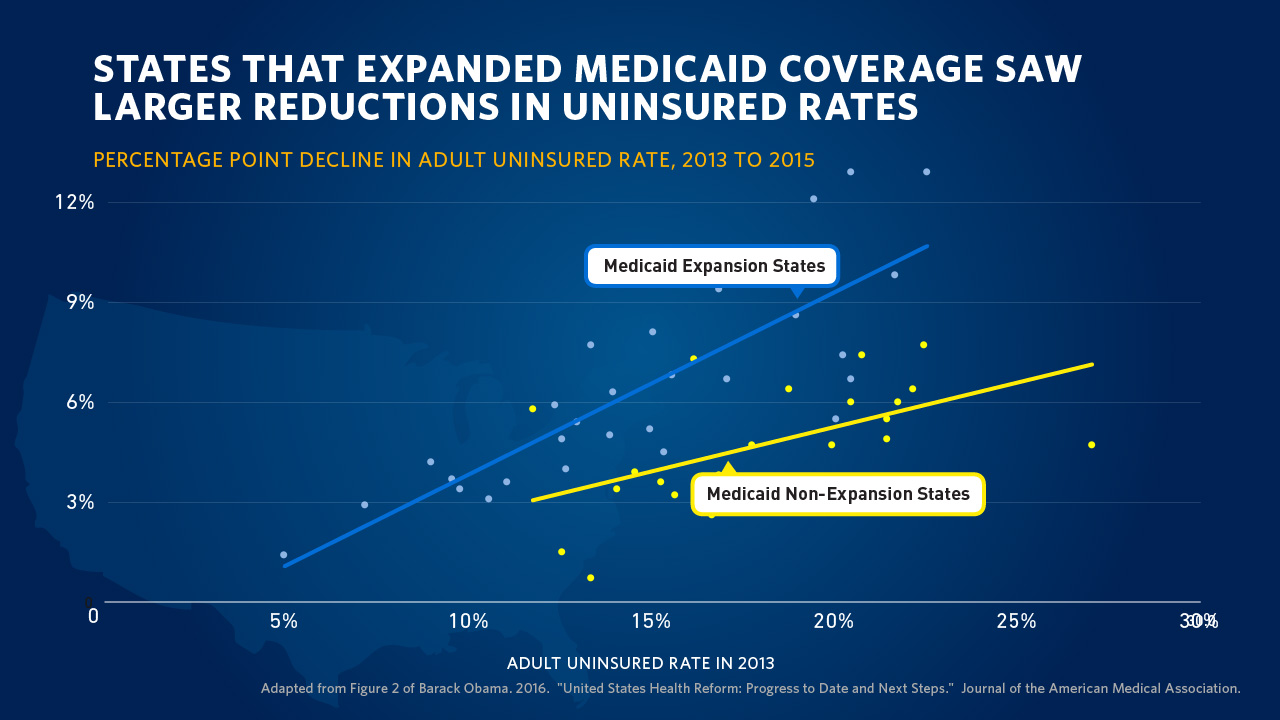


 I am so grateful to Tom Lawry for asking me to pen the foreword for his book, Health Care Nation,
I am so grateful to Tom Lawry for asking me to pen the foreword for his book, Health Care Nation,  Thanks to Feedspot for naming this blog, Health Populi, as a
Thanks to Feedspot for naming this blog, Health Populi, as a